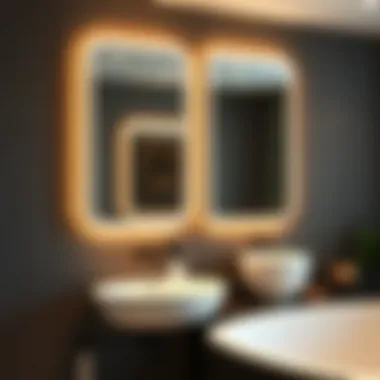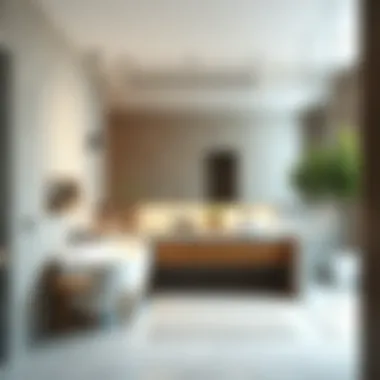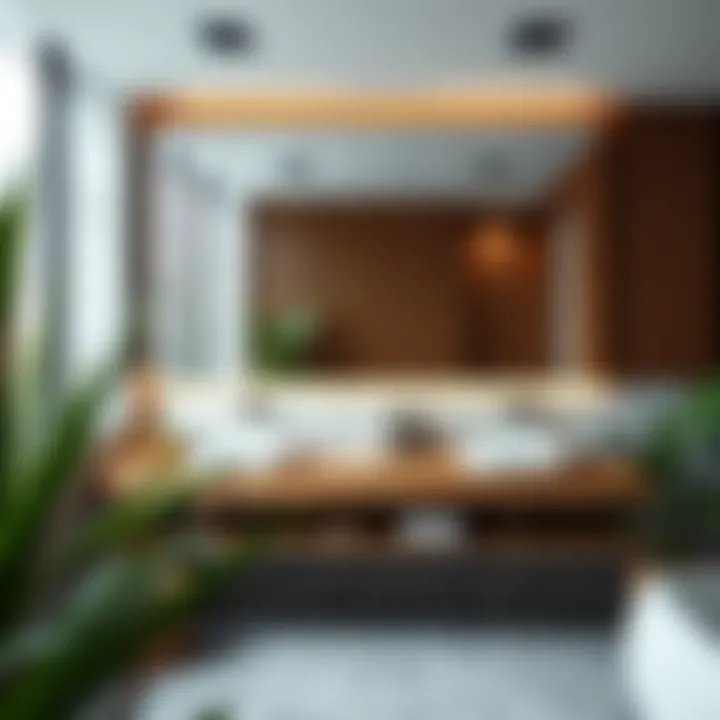Large Mirrors in Bathrooms: Design & Trends


Intro
When it comes to creating a balanced and inviting bathroom atmosphere, large mirrors play a significant role. They can make small spaces appear larger, enhance lighting, and serve as vital style statements. This is a focus not only for homeowners looking to upgrade their living spaces but also for professionals like interior designers and architects who seek to fuse form and function.
As the functionality of bathrooms evolves, so too does the role of large mirrors within these settings. They’re no longer just practical; they are also key elements in shaping aesthetics. This article intends to dig deeper into the design trends, functionality, and recent developments surrounding large mirrors. From contemporary styles to practical installation tips, readers will find a comprehensive guide that can leave a lasting impact in their bathroom designs.
Design Trends
Contemporary Styles
When discussing the current landscape of large mirrors in bathrooms, contemporary styles are at the forefront. Often characterized by clean lines and minimalistic forms, these mirrors fit seamlessly into modern architecture. Round mirrors, for example, evoke a softness that contrasts the typical square or rectangular shapes, adding a touch of elegance. Moreover, mirrors with integrated lighting have surged in popularity. They offer both practicality—illuminating the face for grooming and self-care—and sophistication, creating a sleek, modern look.
Many designers are also opting for vintage-inspired mirrors, which bring a sense of nostalgia to the space while complementing modern fixtures. Statement pieces like oversized sunburst mirrors or distressed wooden frames can serve as stunning focal points. Notably, these styles reflect a desire for personalization in bathroom design.
Color Palettes and Materials
Mirrors come in various materials and colors, and selecting the right combination can significantly affect the overall bathroom ambiance. Metallic finishes, such as brass or gold, are particularly trendy right now, lending an air of luxury and sophistication. The warmth of brass can make cold tiles feel more inviting. On the other hand, sleek chrome is often paired with minimalist designs for a chic, modern look.
As for color palettes, consider the broader bathroom environment. If the space employs neutral wall colors, a boldly colored mirror frame – perhaps deep navy or emerald green – can create an attractive contrast. Wooden frames, stained in warm hues, can add a feeling of coziness against stark tiles.
Mirrors made from eco-friendly materials are gaining traction, too. Sustainable design appeals not just to the environmentally conscious but increasingly reflects a modern ethos of responsibility in home improvement.
Functional Solutions
Ergonomic Furniture
Mirrors can also be a part of a more ergonomic approach to bathroom design. Choosing the right size and placement for your mirror is essential. A large mirror placed at eye level can reduce strain while getting ready. Furthermore, mirrors that easily tilt or pivot can add ease for people of various heights. It’s important to think about how the mirror interacts with other elements in the room, such as cabinets and sinks, ensuring that everything flows well together.
Space Optimization Tips
In smaller bathrooms, large mirrors can create the illusion of more space. Installing a mirror across from a window, for instance, can enhance the natural light, making the room feel airier. Reflective surfaces can multiply light, while well-placed mirrors can lead the eye to various focal points in a bathroom.
Some homeowners opt for mirrored storage solutions, blending function with style. Mirrored cabinets can hide items away while contributing to the room’s visual impact. These choices not only save space but also maintain a sleek appearance without clutter.
"Incorporating large mirrors in a bathroom isn’t just about glamour; it’s about designing a space that feels intimately spacious and functional."
Selecting the right large mirror involves understanding its design and functional aspects while embracing modern trends. The perfect mirror can transform a mundane bathroom into an inviting sanctuary where every glance reflects care and consideration.
The Role of Large Mirrors in Bathroom Design
Large mirrors in bathrooms are not merely functional accessories; they play a pivotal role in shaping the overall ambience and utility of the space. When thoughtfully integrated, these reflective surfaces can transform a mundane bathroom into a sanctuary that combines style with functionality. This section explores the significance of large mirrors, focusing on how they enhance the visual space and contribute to aesthetic considerations.
Enhancing Visual Space
In smaller bathrooms, the challenge often lies in making the space feel larger. Large mirrors can trick the eye and create an illusion of depth. By reflecting light and colors from the surroundings, they can bounce brightness around, giving an ethereal quality that expands the perceived area. This technique isn’t just for small confines; larger rooms can also benefit by creating focal points, drawing the eye upward and amplifying vertical space.
Consider a narrow bathroom where a large rectangular mirror stretches across the wall above the sink. The mirror doesn’t just serve the functionality of reflection; it also creates the impression of an airy atmosphere. Much like how a window brings the outside in, a well-placed mirror can offer a semblance of vastness, making the space feel deliberately grander.
A mirror can be the unsung hero in bathroom design, especially when it comes to maximizing visual space.
Aesthetic Considerations
When it comes to bathroom design, aesthetics are paramount. A large mirror can serve as a statement piece or a subtle complement, depending on its style and placement.
The finish of the mirror’s frame can echo the other materials used in the bathroom. For instance, a wooden-framed mirror ties in natural elements, perfect for those leaning towards a rustic or earthy feel. On the other hand, sleek metallic frames can impart modern sensibilities, harmonizing beautifully with chrome fixtures and contemporary tiles.
Additionally, the style of the large mirror often reflects the design themes chosen for the entire bathroom. Whether it’s a vintage, ornate mirror or a more minimalist piece, these options allow the homeowner or designer to express personality and taste. Thus, selecting a mirror involves more than just functionality; it requires thoughtful deliberation on how it embodies the bathroom's overall character.
Choosing the right mirror involves a balancing act between visual appeal and practical needs, ensuring that shape, style, and lighting all work in concert to create the desired atmosphere.
Functional Benefits of Large Mirrors
Large mirrors in the bathroom serve more than just a decorative purpose. They bring a multitude of functional advantages that contribute significantly to both the usability and overall ambiance of the space. Understanding these benefits can help homeowners and interior designers alike make informed choices that enhance the bathroom experience. Here, we will delve into two key areas: improved lighting and practicality in grooming activities.
Improved Lighting
One cannot underestimate the role of lighting in a bathroom. Proper lighting not only makes it easier to see but also influences the overall mood of the environment. Large mirrors function as reflective surfaces that can amplify natural light.
When strategically placed against windows, they can redirect sunlight deeper into the room, virtually doubling the effect of the light entering. This effect makes small bathrooms feel airier and brighter, creating a cheerful atmosphere.
"Mirrors reflect light like a thousand suns, brightening the space without any need for additional fixtures."
Moreover, mirrors can also work hand-in-hand with artificial lighting. For example, incorporating backlit mirrors provides an even glow, eliminating those unflattering shadows that can occur when one uses only overhead lighting. This not only makes for a more flattering appearance but also ensures you are well-lit while performing daily grooming tasks.
Practicality in Grooming Activities
Another significant advantage of large mirrors lies in their practicality, especially when it comes to grooming activities. Imagine the daily routine: shaving, applying skincare, doing hair. A larger surface area allows for a more comprehensive view of one’s reflection, enabling better precision while performing these tasks.


In homes where multiple people share a bathroom, having a spacious mirror can ease the morning rush. Everyone can use it comfortably at the same time, avoiding the hassle of waiting in line. This shared resource becomes not just about reflection, but also about enhancing the functionality of bathroom operations.
Additionally, full-length mirrors can help in checking outfits from head to toe. It allows individuals to consider their entire appearance without the limitation of a small mirror that only shows the upper body.
Incorporating large mirrors also means less strain on the eyes. Smaller mirrors, particularly when hung at incorrect heights, can force users to awkwardly lean in or squint to get a good look, sometimes resulting in accidents.
In summary, the functional benefits of large mirrors extend well beyond mere aesthetics. They enhance lighting conditions, improve the practicality of grooming routines, and contribute to a more user-friendly environment in the bathroom setting.
Design Styles for Large Bathroom Mirrors
In the world of bathroom design, the choice of large mirrors transcends mere function; they can act as focal points that shape the entire ambience of the space. Selecting the right design style for these mirrors not only enhances the visual appeal but also complements other elements of the bathroom. Understanding different design styles is crucial as it allows homeowners, interior designers, and architects to curate a cohesive look, ensuring that the mirrors fulfill both aesthetic desires and practical requirements. Here, we explore several popular design styles for large bathroom mirrors and their unique characteristics.
Contemporary Designs
Contemporary bathroom mirrors are often sleek and stylish, embodying a modern approach that resonates with current trends. These designs frequently incorporate clean lines, geometric shapes, and a minimalist aesthetic, making them ideal for modern settings. For instance, a rectangular mirror with a thin matte black frame could serve as both a functional piece and a striking design element. It's essential to choose mirrors that reflect current color palettes—neutrals combined with pops of color can instill vitality in a contemporary bathroom layout.
- Key Features:
- Striking geometric patterns
- Slim, undefined borders
- Innovative shapes, like asymmetric designs
Contemporary mirrors often use advanced materials and technologies. For example, LED backlighting integrated within the mirror itself can create a warm glow, enhancing both visibility and the bathroom's atmosphere. Opting for a mirror that reflects personal taste—while keeping in line with modern sensibilities—ensures a cohesive design narrative.
Classic and Vintage Touches
For those who lean towards a more timeless look, classic and vintage-style mirrors can infuse a sense of warmth and nostalgia into bathroom spaces. This design approach embraces ornate frames and intricate detailing, such as carvings or antique finishes, which can provide a refined elegance to any bathroom. A large, oval-shaped mirror framed with gold leaf can transform a simple bathroom into a luxurious retreat.
- Typical Characteristics:
- Elaborate frames with historical significance
- Curved and soft forms
- Usage of vintage glass with slight imperfections for authenticity
Incorporating classic designs conveys a commitment to tradition, often reflecting styles from different eras such as Georgian or Victorian. The charm of these mirrors resonates well with traditional fixtures like clawfoot tubs and wooden vanities, enhancing the overall character of the space.
Minimalist Approaches
The minimalist approach suggests that sometimes less truly is more. In bathroom settings where simplicity reigns, opting for unadorned large mirrors may be the best choice. These mirrors typically feature smooth surfaces without elaborate decorations, often coming in unique shapes such as circular or square to break the monotony. In a truly minimalistic space, the mirror itself becomes a piece of art, reflecting the surrounding environment without distracting from it.
- Characteristics of Minimalist Mirrors:
- Clean lines and open space
- Neutral color palette to enhance tranquility
- Focus on functionality while eschewing excess
A well-placed minimalist mirror can open up a small bathroom, creating a feeling of spaciousness and uncluttered calm. Pairing such mirrors with simple fixtures and understated materials contributes to a serene and harmonious atmosphere.
In summary, choosing the right design style for large bathroom mirrors involves understanding how these elements interact with the overall design of the space. Whether opting for contemporary, classic, or minimalist styles, a thoughtful design choice enhances the bathroom experience and reflects individual tastes.
Choosing the Right Size and Shape
When it comes to large mirrors in bathrooms, the adage "size matters" takes on a whole new meaning. Choosing the right size and shape is not merely about aesthetics; it’s about functionality and enhancing the overall experience of the bathroom space. A mirror serves as a focal point in a bathroom, and when it’s correctly scaled to the environment, it can elevate the design significantly. This section dives into how proportionality and shape are critical factors in this decision-making process.
Proportionality to Bathroom Size
Finding the right size mirror involves acknowledging the dimensions of the bathroom. An oversized mirror in a compact bathroom can overwhelm the space, while a diminutive one in a spacious area can fall flat, almost like a wallflower at a party. To strike the right balance, consider these elements:
- Scale: A good starting point is ensuring that the mirror does not dominate the walls but still commands attention. Often, the width of the mirror should be about two-thirds the width of the vanity or sink area it complements. This proportionality creates harmony.
- Height considerations: If your ceiling is high, a taller mirror can make a massive difference, drawing the eye upward and creating a sense of loftiness. Alternatively, in lower-ceiling bathrooms, a horizontally oriented mirror might be more suitable to create visual flow.
- Functionality: Think about how the mirror is used. If daily grooming is involved, the size should allow for a clear view of the whole face and hair. Consider not just the visual appeal but how the mirror's size will aid practical activities in the bathroom.
In the end, it's about creating a space that feels both functional and inviting. An oversized mirror might feel like it’s hogging all the limelight, while an undersized one can make the room feel disjointed.
Shapes: Round, Rectangular, and Custom Options
The shape of a mirror can dramatically impact the overall vibe of the bathroom. Different shapes can complement various design styles and bring about distinctive emotional responses. Here's a look at the popular shapes:
- Round mirrors: Often associated with softness and tranquility, round mirrors can soften sharp lines in modern bathrooms, creating an inviting atmosphere. They are also practical, as they eliminate corners, making them easier to clean and maintain. Using a round mirror above a vanity can introduce a sense of balance that is both attractive and functional.
- Rectangular mirrors: These are the workhorses in the world of bathroom design. A rectangular shape often suggests order and precision, working well in contemporary or minimalist spaces. Plus, they maximize the available reflective surface, making them a default choice for many.
- Custom shapes: Tailoring a mirror's shape can be a means of personal expression. Whether it's an asymmetrical design that embodies creativity or a unique contour that matches other elements in the bathroom, bespoke mirrors stand out. They can be the signature piece that sets the tone for the entire room.
In summary, the shapes and sizes of mirrors are more than simple design choices. They influence how light interacts within the space, dictate the overall style, and affect how one feels about the bathroom as a whole. The choices made here create a ripple effect throughout the design process.
Material Options for Large Mirrors
When it comes to large mirrors in bathrooms, the materials used can significantly influence both aesthetics and functionality. Not all materials are created equal; some boast durability while others make for a striking visual centerpiece. Choosing the right material isn’t just about looks—it also impacts safety, maintenance, and integration with existing design elements. Let’s take a deeper look into the options available.
Framed vs. Frameless Mirrors
The debate between framed and frameless mirrors often ignites passion among homeowners and designers alike. Framed mirrors can add a decorative touch, creating a contrast to sleek bathroom finishes. For instance, a rustic wooden frame can imbue a sense of warmth, complimenting natural material like stone or wood vanities. This type of mirror becomes a statement piece.
On the other hand, frameless mirrors lead to a more modern and minimalist appearance. They blend effortlessly with various design styles, providing a spacious feel—especially valuable in smaller bathrooms. The seamless look of a frameless mirror allows it to pair beautifully with chic fixtures, offering a contemporary edge.
Ultimately, the decision may hinge on the overall bathroom design. Framed mirrors might enhance charm in a vintage-styled room, while frameless mirrors could elevate a sleek, modern space.
Glass Types: Regular, Tempered, and More
Different types of glass carry distinct properties, affecting safety and longevity in a bathroom environment. Regular glass is used widely but comes with risks like breakage, especially in wet areas. Tempered glass, however, is a sturdier option, created through heat treatment, allowing it to withstand impacts far better than its regular counterpart. If shattered, tempered glass crumbles into small, blunt pieces—lessening injury risks.


Furthermore, one might encounter laminated glass. This version consists of layers bonded together, enhancing safety and sound absorption. Though generally used in windows, it can also be applied creatively in bathroom mirrors, providing added peace of mind.
Not forgetting aesthetics, mirrored acrylic is another fantastic option. Lightweight and shatter-resistant, it offers versatility, allowing you to cut and shape mirrors to suit any space or design scheme.
Reflective Coatings and Their Benefits
Reflective coatings can enhance the functionality of mirrors beyond mere reflection. Anti-fog coatings are particularly beneficial in bathrooms where humidity levels can soar. Such coatings ensure that your mirror remains clear, eliminating the frustration of fogging after a hot shower.
Moreover, there exists a variety of reflective options that can impact brightness and create visual depth. For example, some mirrors come with enhanced silver backing, which can boost luminosity—this feature is excellent for dimly lit spaces. By increasing the reflectiveness, the mirror amplifies the light present in your bathroom, thus creating a more open and inviting atmosphere.
In summary, the material choice affects not only the visual appeal of your bathroom but also its atmosphere and overall safety. Understand the available options, weigh their pros and cons, and align them with your specific stylistic and practical needs.
Installation Considerations for Large Mirrors
The installation of large mirrors in bathrooms goes beyond merely hanging a piece of glass on a wall. It is a matter of precision, attention to detail, and the understanding of various factors that can significantly influence the overall effectiveness and safety of the fixture. Proper installation can make all the difference between a luxurious feel and, frankly, a disaster waiting to happen.
When it comes to large mirrors, one must consider wall preparation, mounting techniques, and the weight and size of the mirror itself. Beyond aesthetics, the functionality of a large mirror hinges on these installation factors. A securely mounted mirror is not just about looks; it ensures safety and provides stability, allowing for everyday use without concern. Therefore, understanding how to install these mirrors competently is crucial for any bathroom renovation or upgrade.
Wall Preparation and Mounting Techniques
Before placing a large mirror, wall preparation is essential. Not every wall is ideal for heavy mirror support. Depending on the wall type—whether drywall, plaster, or concrete—different approaches should be taken.
- Check the Wall Type: Understand what your wall is constructed of. Drywall can be reinforced with studs while concrete may necessitate specialty anchors.
- Reinforce the Area: For heavy mirrors, adding reinforcement boards can help distribute the weight evenly. This is particularly important in high-humidity environments like bathrooms, where moisture can compromise the structural integrity over time.
- Tools and Anchors: Utilize the right tools. A cadre of anchors specifically designed for the weight of your mirror—whether toggle bolts, molly bolts, or heavy-duty screws—is necessary.
Once the wall is prepped, the next step is positioning the mirror.
- Mark the Position: Use a level to mark where the top and sides of the mirror will align. Ensuring it’s level is paramount; a crooked mirror can throw off a whole bathroom's elite vibe.
- Mounting Technique: There are multiple mounting techniques to consider—hanging brackets, adhesive mounting strips for lighter models, or directly screwing into wall anchors for heavier mirrors.
Each approach has its pros and cons, so it may be wise to consult with professionals or refer to manufacturer instructions tailored for specific mirror types.
Safety and Structural Integrity
Safety in a bathroom environment cannot be overstated. Large mirrors, while stunning, can pose a hazard if not correctly installed.
- Weight Distribution: Understand that mirrors come with varying weights based on size and material. Overestimating the strength of your mounting technique can lead to accidents. It’s advisable to choose mirrors designed specifically for wall mounting and to ensure you follow the manufacturer's guidelines for installation.
- Structural Integrity: The wall must be able to support the mirror’s weight over time without weakening. Regular checks afterward to assess any loosening or shifting are crucial.
- Use of Safety Glass: Opt for mirrors made from tempered glass. This type of glass is less likely to shatter upon impact, reducing potential injury risks. Many contemporary mirrors come with safety features such as protective backings that can help mitigate damage in the unfortunate event of an accident.
Maintenance and Care for Mirrors
Maintaining bathroom mirrors isn’t just about keeping them clean; it’s about sustaining their integrity and functionality for years to come. Having large mirrors in your bathroom can elevate the space significantly. However, without proper care, they can quickly lose their luster and even become damaged. Emphasizing the maintenance of mirrors is essential, as it enhances both the aesthetic appeal and the practicality of these features. Understanding the specific requirements for upkeep ensures that not only do mirrors maintain their reflective capabilities, but they also prolong the lifespan of any additional features they hold.
Cleaning Techniques
Cleaning a large mirror properly requires a mindful approach. The wrong products or methods can leave streaks or damage that may lead to costly replacements.
- Use Soft Cloths: Always opt for microfiber cloths or soft cotton to avoid scratching the surface.
- Gentle Cleaners: Mix water with a little bit of liquid dish soap or opt for specialized glass cleaners. Avoid strong chemicals that could damage the reflective coating.
- Circular Motion: Wipe in circular motions rather than straight lines. This technique helps avoid streaks and ensures an even clean.
- Avoid Abrasives: Stay clear of steel wool or scouring pads—these can wreak havoc on your mirror's surface.
A little routine cleaning goes a long way—establishing a habit of wiping down mirrors weekly can help keep them looking new long-term.
Preventing Damage and Wear
Mirrors face various threats, from moisture and humidity to physical damage, especially in a bathroom. Prevention is key in maintaining their appearance and function.
- Humidity Control: Excess humidity can cause the backing of the mirror to deteriorate. Use exhaust fans while taking showers.
- Regular Inspections: Routinely check for signs of damage, like fogging or corrosion around the edges.
- Avoid Direct Contact: Try not to bump or knock against the mirror, which can lead to cracks or chips.
- Proper Hanging Techniques: Ensure heavy mirrors are mounted securely, using appropriate hardware to prevent falls.
While large mirrors serve essential functions, neglecting their care can result in costly consequences. By routinely cleaning with the appropriate techniques and implementing preventive measures, homeowners can enjoy the beauty and functionality of their bathroom mirrors for the long haul.
"A clean mirror is just as important as a good reflection—both require attention and care for meaningful results."
For more information on mirror maintenance and cleaning techniques, consider visiting resources like Wikipedia, or check out tips from experts on platforms such as Reddit.
Current Trends in Bathroom Mirror Designs
The landscape of bathroom mirror design has shifted dramatically in recent years. Today, mirrors are more than mere functional elements; they are stylish accessories that can transform the overall ambiance of a bathroom. As homeowners and designers alike seek to innovate, staying abreast of current trends becomes critical. These trends reflect not only aesthetics but also a growing understanding of how functionality and technology can enhance the user experience.
Smart Mirrors
In the realm of modern bathroom design, smart mirrors are taking center stage. Imagine stepping into your bathroom and being greeted by a mirror that can adjust to your lighting preferences, display weather updates, or even offer skincare tips. Smart mirrors merge technology and practicality, making them increasingly popular in bathrooms.
The appeal of smart mirrors comes from their ability to integrate functionality seamlessly into daily routines. Features such as built-in touchscreens, Bluetooth connectivity, and even voice activation are becoming standard. Homeowners appreciate these functionalities, as they save time and make everyday tasks more enjoyable. For instance, a mirror that can show video tutorials for grooming or makeup application while you prepare for the day adds a layer of convenience that traditional mirrors simply cannot offer.
Benefits of Smart Mirrors:
- Enhanced Task Efficiency: Completing tasks like makeup application can be more straightforward with a mirror that provides natural lighting and instructional videos.
- Space-Saving Technology: Many smart mirrors are designed with minimalism in mind, reducing the need for additional gadgets cluttering your countertops.
- Energy Efficiency: Certain smart mirrors come with energy-efficient LED options that can help lower your electricity bill.
Incorporating a smart mirror into a bathroom design elevates the space into one that embraces modern living, making it a valuable consideration for homeowners looking to enhance functionality without sacrificing style.
Backlit Mirrors and Lighting Options


Backlit mirrors are another trend gaining traction, capturing the balance between functionality and aesthetics. These mirrors utilize LED lighting placed along the edges or behind the glass, creating an ethereal glow that enhances the space.
This illuminated effect can significantly enhance the ambiance of the bathroom, making it feel more spacious and inviting. Backlit mirrors also serve a practical purpose. Poor lighting is often a challenge in bathrooms, and backlit mirrors help to mitigate these issues by providing an even distribution of light, which is essential for tasks like shaving or applying makeup.
Additionally, backlighting allows for versatility. Many of these mirrors come with adjustable brightness, letting users set a softer light for relaxation or brighter settings for more detailed grooming tasks. This adaptability is crucial, as it caters to various moods and requirements throughout the day.
Benefits of Backlit Mirrors:
- Visual Appeal: The warm glow adds an artistic touch that can be a statement piece in the bathroom.
- Improved Visibility: Enhanced lighting helps prevent mishaps while performing delicate tasks like makeup application.
- Modern Aesthetic: The sleek look of a backlit mirror fits perfectly into contemporary bathroom designs, elevating overall style.
By incorporating backlit mirrors, designers can create spaces that are not just functional but are also aesthetically pleasing, fostering an environment conducive to relaxation and rejuvenation.
"In modern design, the marriage of technology and style is not just preferable; it is becoming essential."
Integration of Large Mirrors with Other Bathroom Elements
When it comes to bathroom design, large mirrors serve a purpose that often extends far beyond mere reflection. They are pivotal in harmonizing the entire bathroom space, influencing not just how a room looks, but how it feels and functions. Integrating these mirrors with other bathroom elements can elevate the overall ambiance and effectiveness of the area. This integration involves careful consideration of several aspects including aesthetics, functionality, and personal preferences, making it a multifaceted endeavor worth exploring.
Coordinating with Vanities and Sinks
To ensure a cohesive look, large mirrors should seamlessly align with the vanities and sinks in the bathroom. The size, shape, and style of the mirror can complement or clash with these key features, impacting the overall feel of the space. For instance, a sleek, frameless mirror may look stunning over a modern vanity with clean lines, while a robust, ornately framed mirror could serve to enhance the charm of a more traditional setup.
It’s essential to consider the height of the mirror in relation to the vanity. If the mirror hangs too high, it may not serve its functional purpose effectively. On the other hand, one mounted too low can feel cramped or crowd the counter space. A good rule of thumb is to position the mirror so that its center aligns with the average eye level of users, keeping accessibility in mind, especially in households with children or individuals who may have mobility concerns.
Additionally, the color palette and materials of the vanity should also inform your mirror choice. If you have a wood vanity, consider coordinating the mirror with a similar wood finish or opting for a contrasting metal framed mirror to create visual interest. This attention to detail underscores the significance of thoughtful integration, fostering a pleasing aesthetic as well as practical functionality.
Synergy with Bathroom Accessories
The way large mirrors interact with bathroom accessories further accentuates their importance in creating a cohesive bathroom design. Accessories like towel racks, soap dispensers, and even lighting fixtures can complement the mirror, helping to create an inviting atmosphere. For instance, if the mirror has a modern sharp edge, accessories that feature sleek metal finishes can continue this theme and flow.
- Use of Colors: Opting for accessories that pick up colors in the mirror's frame can tie everything together. For example, a gold-framed mirror paired with gold towel holders adds a unified luxe feel to the space.
- Thematic Consistency: Accessories should support the overall theme of the bathroom. If your choice of mirror has a rustic appearance, consider woven baskets or wooden storage solutions to maintain that natural vibe.
- Layered Lighting: When considering mirrors, take into account how lighting—both natural and artificial—will play off the reflective surfaces. Fixtures that provide additional illumination can enhance the mirror’s capabilities, allowing it to contribute to brightening the space effectively.
By thoughtfully coordinating a large mirror with vanities and accessories, one can transform a bathroom from the mundane into a harmonious oasis. This synergy of elements not only enhances the visual appeal but also promotes a functional environment that's conducive to daily rituals. The integration of large mirrors proves to be a strategy that can breathe life and character into even the most basic bathroom layouts.
Environmental Considerations in Large Mirror Selection
When it comes to large mirrors in bathrooms, environmental considerations play a crucial role in selecting the right piece. As we move towards a more eco-conscious society, the choice of materials and energy usage in design becomes essential. Not only do large mirrors enhance the aesthetic appeal of a bath space, but ensuring that their selection aligns with environmental sustainability can lead to both personal satisfaction and broader ecological benefits.
Sustainable Materials
You get what you pay for, as they say. Choosing mirrors made from sustainable materials might initially cost more, but the long-term benefits can be significant. Sustainable options, like bamboo-wood frames or recycled glass, offer alternatives that reduce environmental impact. These materials help minimize carbon footprints and lessen the demand for virgin resources.
Considering the life cycle of a mirror is vital. Mirrors that incorporate eco-friendly materials often undergo less harmful production processes. For instance, bamboo grows rapidly, making it a renewable resource that can be harvested without like most other timber types that take decades to mature.
Some manufacturers are now focusing on eco-labels to inform consumers about the sustainability of their products. Look for certifications like FSC (Forest Stewardship Council) or Cradle to Cradle, which ensure that the materials meet stringent environmental standards.
Energy-Efficient Lighting Options
Energy efficiency doesn’t stop at the mirror itself. The type of lighting used in conjunction with large mirrors significantly impacts overall energy consumption. Opting for LED backlighting is one of the simplest ways to make your bathroom’s light sourse more environmental-friendly. LEDs consume up to 75% less energy than traditional incandescent bulbs while lasting much longer.
Beyond the choice of bulbs, it’s important to consider the placement of lighting around large mirrors. Strategically positioning light fixtures can ensure that light reflects properly, enhancing visibility without over-illuminating the space. This careful planning not only contributes to a visually appealing setting but also prevents excess energy waste.
In addition, modern smart systems can regulate lighting based on the time of day, which can optimize energy savings further. These systems can dim lights when natural light is available or turn them off entirely when no one is in the room, proving that a proactive approach to energy use can produce tangible savings on utility bills.
"By making mindful choices in mirror selection and illumination, we take steps toward not just a beautiful bathroom but a greener planet."
Considering sustainable materials and energy-efficient lighting helps ensure that large mirrors in bathrooms aren’t just functional or stylish but are also aligned with growing environmental awareness. As designers, architects, and homeowners move into the future, these elements will remain pivotal in building design that is both captivating and conscientious.
For further reading about sustainable home design practices, you can visit Wikipedia on Sustainable Home Design or consult resources such as US Green Building Council.
In summary, understanding environmental considerations in large mirror selection fosters a more responsible way to approach bathroom design, ultimately resulting in spaces that resonate with both elegance and ecological integrity.
The Emotional Impact of Mirrors in Bathrooms
Mirrors in bathrooms are not just functional accessories; they play a significant role in shaping the emotional experience of this personal space. From creating a calming atmosphere to serving as a source of confidence, large mirrors can influence how one perceives their surroundings and themselves. This section explores these emotional dimensions, emphasizing how thoughtful mirror selection and placement can enhance the overall ambience of the bathroom while encouraging self-reflection—literally and metaphorically.
Creating a Sense of Calm
A well-designed bathroom can be a sanctuary away from daily chaos. Large mirrors contribute to this calm, as they enhance the sense of space, making it feel more airy and open. Imagine stepping into a bathroom, and the first thing you notice is a beautifully framed mirror that reflects soft natural light streaming through a window. The sensation can be soothing, almost like a gentle embrace.
Using mirrors strategically can help to amplify tranquil colors and textures, making the space feel serene and inviting. For instance, placing a large mirror across from a window can draw in natural light, bathing the room in brightness while reflecting soothing views of nature. This setup not only makes the room seem larger but also cultivates an atmosphere of peace, encouraging relaxation.
Additionally, mirrors can serve to reduce visual clutter. When arranged correctly, they can hide unattractive areas or objects, allowing for a more polished aesthetic—essential for a calming environment. Some homeowners even choose mirrors with soft, curved edges instead of harsh, angular lines to further that peaceful vibe. The experience is akin to finding a quiet corner in a bustling café, offering solace within a busy lifestyle.
Boosting Confidence and Individuality
In the realm of personal grooming and self-care, large mirrors are indispensable. Beyond their basic function, they act as powerful tools for self-affirmation. Standing before a well-lit mirror, individuals can prepare for the day ahead, assess their attire, and engage in self-reflection. This act of self-checking can serve as a confidence booster, helping individuals feel more in control and poised.
Mirrors allow for the exploration of personal style. One can experiment with different looks, whether it's a trendy haircut or a bold makeup choice. This freedom can significantly add to an individual’s sense of identity and self-expression. When one sees themselves looking their best in a beautiful large mirror, it’s hard not to feel a swell of pride. The choice of mirror can also highlight individuality— from ornate, vintage styles that speak to nostalgia to sleek, modern designs that reflect contemporary tastes.
Incorporating motivational quotes or personal mementos around the mirror's vicinity can further enhance its role in boosting confidence. Such touches remind individuals of their journey and personal growth, which is particularly impactful in a space dedicated to self-care.
"A mirror reflects only what is there; it has no emotional influence unless we give it one. But the right choices around mirrors can transform that reflection into a celebration of self."
Through careful selection of both the mirror and its surroundings, it becomes possible to create a bathroom environment that not only looks aesthetically pleasing but also emotionally fulfilling.















